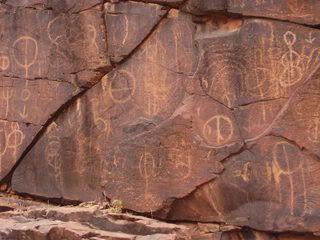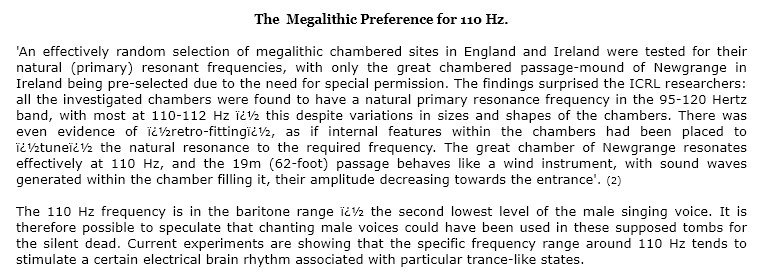About below story at FT on spirals on walls of a buried building in Sardinia...the same spiral seems to appear also in Alaska.
Story showing a spiral symbol in Alaska:
http://www.capitalcityweekly.com/storie ... 3635.shtml
---------------------------------------
The FT Article:
forteantimes.com/strangedays ... round.html
Link is dead. The MIA webpage can be accessed via the Wayback Machine:
https://web.archive.org/web/2014120...ays/archaeology/3748/spirals_underground.html
STORY TEXT:
Diego and Paola Meozzi, the Italian archæology journalists who produce the admirable Stone Pages website, have alerted the outside world to an amazing discovery on the Italian island of Sardinia. It involves a Neolithic site now referred to as tomba della scacchiera (“the chequered tomb”), near Bonorva. Diego and Paola met a local man, Antonello Porcu, who told them about the site. In 2007, the Bonorva municipality initiated an archæological survey of the area, where there is a known prehistoric necropolis. This led to an excavation programme in 2008. Despite the lead archæologist saying that they hadn’t yet found anything of interest, Porcu noticed that for several consecutive days workers coming down from the excavation area were covered by rock powder. He queried them in Sardinian (not the same as Italian) and they hinted that something remarkable had been uncovered up in the hills. Their curiosity tweaked, Porcu and his brother went up there. They were staggered by what they found.
Peering beneath a groundsheet placed there by the excavators, the Porcu brothers discovered an entrance passage with a rock-cut façade leading into a large tomb with three side cells. The tomb interior has huge bull horns carved on the long side of the main chamber, whose stone roof is carved in a way reminiscent of timber planks and is painted in dark blue and white. But most striking of all is a series of seven bright red ochre spirals, each up to 70cm across, painted on a side cell; they were executed with skillful bravura. On the roof of a side cell there is also a geometric figure very rarely found in a Sardinian tomb – a black and white chequered motif. The best guess so far is that the monument dates to the so-called Ozieri culture (3800 to 2900 BC).
Stirred by this find, Antonello Porcu informed the mayor of Bonorva. The man was astonished, saying he had not been informed about it by anyone connected with the survey. Fortunately for us, Porcu had the presence of mind to take photographs of the tomb’s interior, because a few months later official representatives of the Soprintendenza Archeological for Nuoro and Sassari (the local branch of the Italian Ministry for Heritage) put a massive block of rock in front of the only entrance of the tomb, filling everything with concrete and covering the whole area with a thick layer of soil, sealing the tomb once again. This was done in order “to protect the tomb against looters”.
The local Sardinian archæological authorities are driven by the desire to protect the site and do not want word spread about it, but Diego and Paola Meozzi disagree. “Our heritage is a national treasure and must be shared: protection is one thing, but hiding an ancient site indefinitely – even if motivated by preservation principles – is something else,” Diego comments. “We wonder just how many remarkable monuments have been found, studied and sealed once again over the years by the archæologists in Sardinia with only a few authorized persons aware of them.” He asks that people around the world send messages to the Soprintendente Archeologico for Sassari and Nuoro (Dr. Bruno Massabò – e-mail address: [email protected]), urging a re-think of the closure policy. So go to it, dear readers. Stone Pages, 21 April 2010.
A concluding observation (remember you read it here first): if we look at the picture here of one panel of the tomb’s paintings, showing spirals either side of a thick vertical line, it calls to mind the arrangement of motifs on the entrance stone to the Neolithic passage grave of Newgrange in Ireland – see the picture of that here also and compare. (Indeed, the motif of spirals either side of a vertical line recur on other nearby Boyne Valley monuments too.) One archæological researcher has already noted that the tomba della scacchiera spirals are more reminiscent of rock art motifs in Atlantic coastal Europe than, say, the painted spirals inside the Hal Saflieni hypogeum on Malta. This could all have implications as to who came from where in prehistory –what more might Sardinia’s other hidden secrets be able to tell us? (Archæologist George Nash, one of this columnist’s editorial colleagues at Time and Mind, is becoming actively engaged in trying to encourage a different heritage approach by Sardinian archæological authorities. See Time and Mind for updates in due course.)
Story showing a spiral symbol in Alaska:
http://www.capitalcityweekly.com/storie ... 3635.shtml
---------------------------------------
The FT Article:
Link is dead. The MIA webpage can be accessed via the Wayback Machine:
https://web.archive.org/web/2014120...ays/archaeology/3748/spirals_underground.html
Spirals Underground
Sardinia's chequered tomb, and the attempts by those in authority to keep it a secret
By Paul Devereux
June 2010
STORY TEXT:
Diego and Paola Meozzi, the Italian archæology journalists who produce the admirable Stone Pages website, have alerted the outside world to an amazing discovery on the Italian island of Sardinia. It involves a Neolithic site now referred to as tomba della scacchiera (“the chequered tomb”), near Bonorva. Diego and Paola met a local man, Antonello Porcu, who told them about the site. In 2007, the Bonorva municipality initiated an archæological survey of the area, where there is a known prehistoric necropolis. This led to an excavation programme in 2008. Despite the lead archæologist saying that they hadn’t yet found anything of interest, Porcu noticed that for several consecutive days workers coming down from the excavation area were covered by rock powder. He queried them in Sardinian (not the same as Italian) and they hinted that something remarkable had been uncovered up in the hills. Their curiosity tweaked, Porcu and his brother went up there. They were staggered by what they found.
Peering beneath a groundsheet placed there by the excavators, the Porcu brothers discovered an entrance passage with a rock-cut façade leading into a large tomb with three side cells. The tomb interior has huge bull horns carved on the long side of the main chamber, whose stone roof is carved in a way reminiscent of timber planks and is painted in dark blue and white. But most striking of all is a series of seven bright red ochre spirals, each up to 70cm across, painted on a side cell; they were executed with skillful bravura. On the roof of a side cell there is also a geometric figure very rarely found in a Sardinian tomb – a black and white chequered motif. The best guess so far is that the monument dates to the so-called Ozieri culture (3800 to 2900 BC).
Stirred by this find, Antonello Porcu informed the mayor of Bonorva. The man was astonished, saying he had not been informed about it by anyone connected with the survey. Fortunately for us, Porcu had the presence of mind to take photographs of the tomb’s interior, because a few months later official representatives of the Soprintendenza Archeological for Nuoro and Sassari (the local branch of the Italian Ministry for Heritage) put a massive block of rock in front of the only entrance of the tomb, filling everything with concrete and covering the whole area with a thick layer of soil, sealing the tomb once again. This was done in order “to protect the tomb against looters”.
The local Sardinian archæological authorities are driven by the desire to protect the site and do not want word spread about it, but Diego and Paola Meozzi disagree. “Our heritage is a national treasure and must be shared: protection is one thing, but hiding an ancient site indefinitely – even if motivated by preservation principles – is something else,” Diego comments. “We wonder just how many remarkable monuments have been found, studied and sealed once again over the years by the archæologists in Sardinia with only a few authorized persons aware of them.” He asks that people around the world send messages to the Soprintendente Archeologico for Sassari and Nuoro (Dr. Bruno Massabò – e-mail address: [email protected]), urging a re-think of the closure policy. So go to it, dear readers. Stone Pages, 21 April 2010.
A concluding observation (remember you read it here first): if we look at the picture here of one panel of the tomb’s paintings, showing spirals either side of a thick vertical line, it calls to mind the arrangement of motifs on the entrance stone to the Neolithic passage grave of Newgrange in Ireland – see the picture of that here also and compare. (Indeed, the motif of spirals either side of a vertical line recur on other nearby Boyne Valley monuments too.) One archæological researcher has already noted that the tomba della scacchiera spirals are more reminiscent of rock art motifs in Atlantic coastal Europe than, say, the painted spirals inside the Hal Saflieni hypogeum on Malta. This could all have implications as to who came from where in prehistory –what more might Sardinia’s other hidden secrets be able to tell us? (Archæologist George Nash, one of this columnist’s editorial colleagues at Time and Mind, is becoming actively engaged in trying to encourage a different heritage approach by Sardinian archæological authorities. See Time and Mind for updates in due course.)
Last edited by a moderator:





